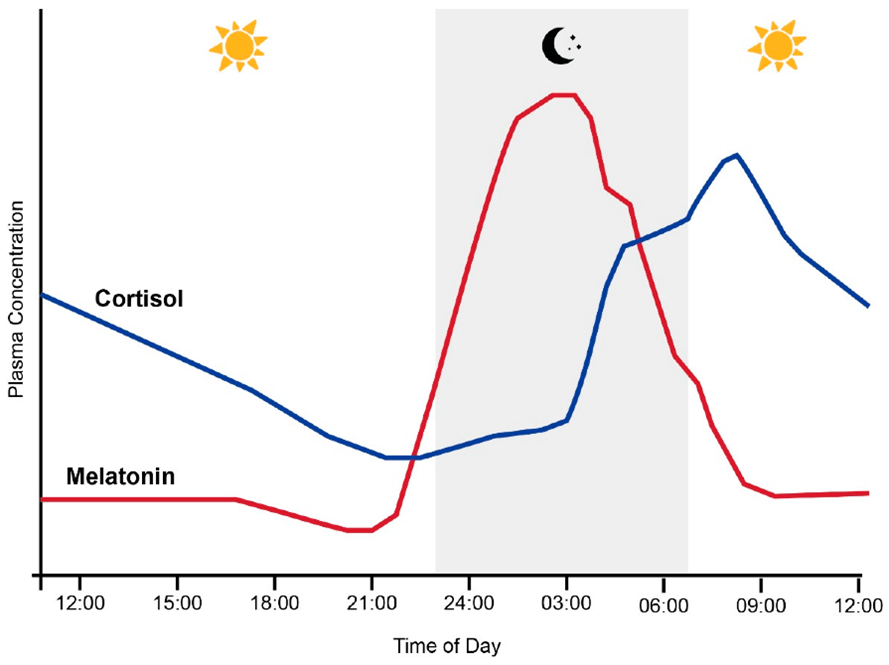In the quiet moments before bedtime, as you lay there with the hope of drifting into peaceful sleep, it can feel like you’re embarking on a mission to catch a mischievous puppy. This playful pup is rather a metaphor for the cortisol and sometimes even adrenaline, brought about by stress bounding around your mind with unruly energy. Just when you think you’ve got the puppy cornered, it slips through your mental fingers, racing away with an enthusiastic burst of thoughts, worries, and stressors. Your thoughts become a game of tag, chasing after the mischievous puppy.
The struggle to calm this “puppy” mirrors the nightly battle to quiet your mind that can sometimes feel impossible. It’s a dance of relaxation disrupted by the erratic movements of our racing minds thinking about work, life, and even stress about the fact that we can’t get to sleep.
How do sleep hormones work?
Put simply, there is a handover from cortisol to melatonin in our systems as we fall asleep every night. The balance between cortisol and melatonin is crucial for maintaining a healthy circadian rhythm. Cortisol and melatonin have an inverse relationship. As cortisol levels rise in the morning to promote wakefulness, melatonin levels are low. Conversely, as the day progresses and cortisol levels decrease, melatonin production increases, signalling the body to wind down and prepare for sleep. You can see this relationship mapped out over time below.

Normal relationship between plasma melatonin and cortisol levels and sleep (grey shading) in humans across the 24 h day. (Robertson-Dixon, Murphy, Crewther, Riddell, 2023)
Adrenaline will interrupt our circadian rhythm too. Adrenaline is different from cortisol. And is usually released when we think about something stressful making ti particularly disruptive when we are trying to sleep. Adrenaline makes the heart beat faster, causes blood pressure to go up and gives you more energy. Cortisol, the primary stress hormone, increases sugar in the bloodstream, enhances the brain’s use of glucose, and increases the availability of substances in the body that repair tissues.
How do we calm the puppy and get to sleep?
In the pursuit of this puppy the key lies not in forceful restraint, but in gentle coaxing. Imagine a mental leash; not tight and restrictive, but loose and reassuring. With a gradual slowing of your breath and a conscious release of tension, you can invite the cortisol puppy to settle down, one bound at a time. It’s a patient process, a choreography of mindfulness that gradually transforms the chaos of cortisol into the serenity of sleep.
Give the puppy (your mind) something to do to keep it calm, and attentive. It needs to be something repetitive, easy, and with very little emotion so as to avoid a spike of adrenaline. You can try…
- Mentally walking through your favourite park with your eyes closed
- Reading a book
- Counting in your head
- Recounting a slow and peaceful song in your head with your eyes closed.
If you need to refocus the puppy and catch it again, you can try deep breathing and even deep sighs. These can help to lower your heart rate and sooth your body.
Remember, that just like naughty puppies, our sleep requires consistent and persistent training. Pick one or 2 methods that appeal or seem most effective and then stick with them. It takes 4-6 weeks to train a new habit. In the same way that anyone who has owned a puppy will know; you don’t get them to be obedient after 3 or 4 days of trying to train them.

So, the next time you find yourself wrestling with the restlessness of bedtime, envision the cortisol puppy, acknowledge its playful energy, and gently guide it towards the peaceful slumber you so earnestly seek. The pursuit of sleep, much like the playful dance with a spirited pup, becomes a journey of patience, understanding, and ultimately, harmony.
If you or your colleagues want to learn more about getting to sleep and better quality rest, get in contact with our friendly team today!
To hear more about health and wellbeing for work and life, follow us on LinkedIn!






